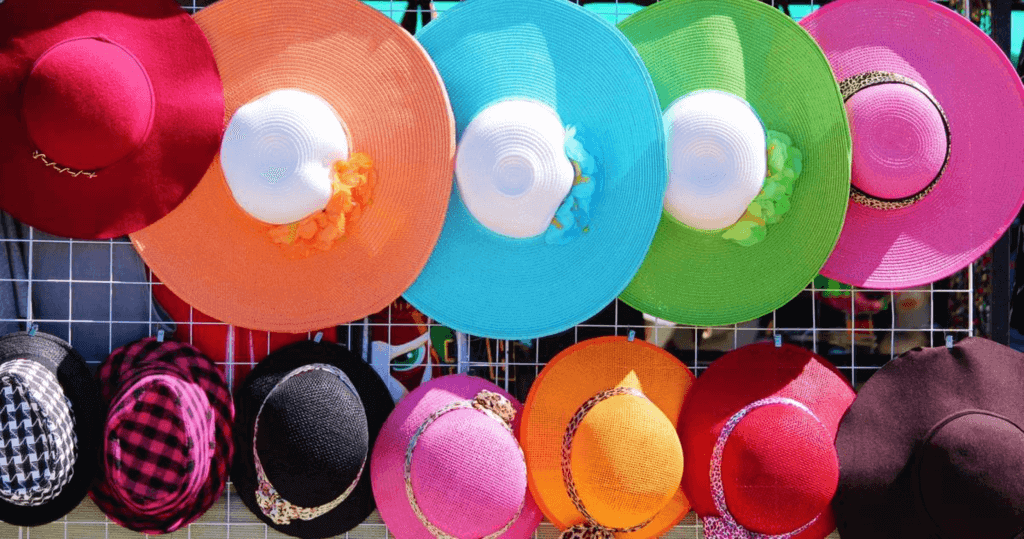National Hat Day
National Hat Day is observed next on Thursday, January 15th, 2026 (41 days from today).

Nowadays, it is not difficult for you to find the right hat for your taste and style. They are very diverse, in terms of style, shape, use as well as national character. There are many different types of hats in the world, each ethnic group has its own hat style. And January 15 every year is a national holiday that takes place to celebrate the hats, also known as National Hat Day.
National Hat Day history
No one knows how the "ancestor" hat was born, but this hat was once a "souvenir" when a slave was freed or changed his status.
Few people know that, from the very beginning, hats were born to serve men, but over the years, they have become indispensable familiar things for women.
It is believed that the first hat appeared before 3000 BC, when a man wearing a leather hat was found in a mountain between Austria and Italy.
Looking at the wide-brimmed hat today, few people can imagine how it has undergone a historical period because in fact, the time of appearance of the first hat is still a big question mark for believers. No one can know how the "ancestor" hat was born, only found signs of birth when seen in a painting at the tomb at Thebes. The painting depicting a man with a stylish straw hat created a wave that started the trend of wearing wide-brimmed hats.
After some time, it was also discovered that the Pileus hat - a simple mushroom head hat - was also one of the pioneering hats. The Greeks and Romans created this hat to be more useful by adding it to a wide brim outside, this is a way to help the user protect the head and help the eyes against light Sun. This new style of hat was named Pestasos and from here on, the name Pestasos became the first wide-brimmed hat in history. In fact, at this time, Roman slaves were not allowed to wear hats, only when they were freed or changed their identity did they receive one as a souvenir.
From this miraculous birth, people also began to see the appearance of the hat in the battle costumes of the warriors. The hat now not only does the job of shading the sun and rain, but also helps the warriors against the opponent. The materials to make the hat are also more demanding, need to have sustainable rigidity such as mortar, thin steel...
During the past several centuries, the first hat began to be used as an important item in everyday life, but it was not until the 14th and 15th centuries that people noticed the development. its strong. The special feature of the hat during this period is that it has accidentally become one of the necessary items associated with men's clothing, while for women, the wide-brimmed hat is just a fashion item until the 18th century
In the 14th century, a hat named Hen nin was born, opening the way for the development of later war hats. High structure, hugging combined with thin chiffon fabric on both sides, the hat became popular among women at that time. The reason this hat has such a large and complex structure is to serve the long hair of the ladies. With this breakthrough in design, the hat has become the focus of attention of many women. Writer Colin McDowell once said, "This is one of the strangest and most impractical pieces of clothing ever born."
By the 15th and 16th centuries, the fashion concept of the hat also gradually changed according to the trend of fashion. This can be considered as a transition period of wide-brimmed hat technology. People are not only focused on hat products for men anymore, but instead, the technology to create hats is divided into two different "paths": one for men - one for women. It is this change that has become the driving force for wide-brimmed hats to grow more and more.
From this period, cone designs began to be "copied" more by manufacturers. People will rely on the hat styles of gentlemen or high classes in society to create mass products. The cavalier hat is an example of the style "copying" of this period.
Entering the 18th century, wide-brimmed hats began to have significant changes. The materials that make up the hat are also gradually improved and closer to people. If in the past the hat was made of rudimentary materials such as animal skin or bark, at this stage, soft wools and silk spandex were more popular. Besides, the image of the hats was also required to be more diverse in style, the designers then began to research to find the hat models suitable for the personality and activities of the people. This is a good sign for the growth of wide-brimmed hats.
In the first half of the 19th century, women seemed to be attracted to hats with decorative accessories such as flowers, feathers... and especially the size of the hat was changed to suit the hair of the sex. The long and wrapped hair has been replaced with a neat short cut, so the size of the hat has also been expanded, now the manufacturer only focuses on the outer rim to increase convenience for women.
Typical types of hats and their origins
Beanie (hooded beanie): Beanies are knitted military hats that have a round or oval shape, a simple, brimless shape and gently hug the head.
Cloche (bell hat): "cloche" means bell in French. The bell cap fits snugly on the head to create certainty because the inside of the hat is deep and round like a bell, somewhat bulging and flared near the ear. The cloche hat is associated with elegant ladies in the 20s.
Bucket hat (beret): almost like a bell hat but with a flat top, shallower inside than a cloche and a wider flared brim.
Fez (felt hat): Turkish felt hat, commonly known as fez, has a truncated cone or short, red cylinder, with a characteristic tassel attached.
Snapback/Baseball cap (baseball cap/hip-hop hat): A baseball cap is a soft hat with a front sunshade designed to be flat instead of slightly curved like a cap. This hat is associated with athletes and sports lovers. Baseball caps first appeared in 1860 when used by a Brooklyn team called Excelsior’s. Later, the hat was modified with many impressive decorations favored by hip-hop performers and music lovers, hence the name hip-hop hat.
Cap (cap): A cap (Northern) or conical hat (Southern) is placed according to the shape of the hat because the sunshade part of the hat is about 15 to 20 cm long in front of the face and the bulb is like a tongue. of son.
Visor (half cap): The same design as a cap but without a cap because of the need to let the head breathe while still protecting the face from the effects of sunlight.
Flat/Ivy/Newsboy cap: The flat cap has a round cap made of soft fabric, can be folded, and the front cap is very short. Flat cap has two typical styles: triangular pointed brim (because it is assembled from one piece and pulled back to the front rim and then sewn) and round rim, also known as newsboy cap because it is associated with the image of boys. Newspaper seller in old England (combined from 8 pieces of fabric held together by a button, the body of the lid is also pulled towards the front rim but less). Born in the 14th century in England, the flat cap was originally worn only by the working class but later was combined by aristocrats with elegant suits and became a fashion icon.
Beret hat: Beret hat is a round, soft hat, usually made of woven wool, felt and does not have a cap like a flat cap. It was first produced in the 19th century in France and Spain. Beret used to be the uniform hat of many military and police units, but now it is very widely used.
Brando/Muir hat (Brando hat): a cap inspired by the hat worn by high-ranking officers and then loved by boys who love to drive big bikes. The name Muir is named after the Muir Cap Company, which produced uniforms for the German army during World War II. The hat is named after the character Marlon Brando in the movie "The Wild One" (1953).
Trilby hat (trilby hat): Trilby is a type of hat with a short brim, the front brim will be lowered and the back brim will be slightly raised. Trilby's fashion was featured in an adaptation of George Du Maurier's 1894 novel Trilby, and the hat quickly became famous under the book's name.
Fedora hat (fedora hat): Fedora is a style of hat with a soft, round and longer brim than the trilby. In addition, the body of the hat is often slightly concave inward. Fedora was first made in 1891, named after the play Fédora performed in America in 1889 and has since become a favorite accessory for both men and women.
Cowboy hat (cowboy hat): Cowboy hats are wide-brimmed suede hats, associated with the image of North American cowboys, influenced by Mexican culture from the 19th century. The top is higher and the flare is much wider and raised than the fedora.
Boater (boater hat): Boater is a type of straw hat with a round brim, round tip, formerly used by sailors to go to sea. Hats often have ribbons for decoration.
Panama hat (Panama hat): has a similar design to a boater, but it comes from Ecuador and is usually made from palm leaves and then dyed white. The tip of the hat is pointed and not flat. The Panama hat (toquilla straw hat) is a traditional Ecuadorian straw hat. Panama hats are bright, light, breathable, and are worn with summer outfits, especially clothes made of linen or silk. This type of hat became popular in the early 20th century as a beach and tropical travel accessory due to its convenience and coolness. Ecuadorian straw hats, along with many other South American goods in the 19th and early 20th centuries, were always brought to the Isthmus of Panama before being carried to Asia, the rest of the Americas, and Europe. For this reason, the hat bears the name of the place of transit — "panama hat" — rather than the name of the place of origin, Ecuador.
Floppy hat (wide-brimmed hat): a floppy hat is a hat with a wide brim, a certain degree of softness to make the face gentle and graceful.
Bowler hat: The melon hat, also known by other names such as coke hat, derby or billycock, are hard hats with a round shape resembling the shape of a melon. The first bowler hat design was introduced in 1849 and was intended for British officers. The melon hats later became popular among the working class during the Victorian era.
Homburg hat (homburg hat): usually made of felt, with only one indentation at the top of the hat (distinguishable from trilby hats), above the brim there is an extra layer of fabric covering the body of the hat and sometimes a feather. It looks very elegant inside.
Top hat: top hat has a high, cylindrical and flat top. The brim is curved and there is a ribbon around the body of the hat. The hat was usually made of felt and was associated with the upper class on extremely formal occasions of the 18th and 19th centuries.
Turban hat (turban hat): a turban hat is actually a long band of scarf that is wrapped many times to form a large hat that is popular in many cultures such as India, Southeast Asia, the Middle East, Arabia, North Africa, East Africa and West Africa.
Trapper (hunter/pilot hat): is a style of hat that is stylized with an ear covering that extends down and is often lined with thick fur to keep warm. Originally, the trapper hat was worn by hunters to protect the head from potential dangers while hunting and also to keep warm. During World War I, the trapper hat was worn by pilots to protect against strong winds from the air when flying open-air planes and later to avoid the high air pressure when flying modified to achieve superior altitude during World War II.
Pillbox hat: The name pillbox hat comes from the shape of a pill-box with straight sides, flat top and no rim. According to the Fashion Encyclopedia, the design began its popularity in the 1930s, but peaked in the 1960s, when it was worn by first lady Jackie Kennedy.
How to observe The National Hat Day
On national hat day, choose your favorite hat to wear on the street. Or you are encouraged to make your own unique hats, bring your own style, or simply transform a traditional hat into a new one. You can also have a small hat party, invite your friends over and ask your friends to bring their hats and stories about them. Take the time to listen to them talk about their own hats. Don’t forget share your story about your hats, your friend’s hats on social media as Facebook, Instagram with the hashtag #NationalHatDay. Have a nice National Hat Day.
Observed
National Hat Day has been observed the third Friday in January (until 2002) | annually on January 15th.Dates
Monday, January 15th, 2024
Wednesday, January 15th, 2025
Thursday, January 15th, 2026
Friday, January 15th, 2027
Saturday, January 15th, 2028


